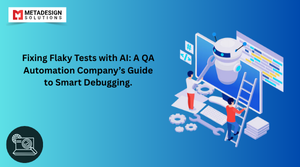1. Introduction to Open-Source QA Automation
Quality Assurance (QA) automation is essential for delivering reliable and bug-free software. While proprietary tools offer advanced features, open-source QA automation tools provide a cost-effective solution without compromising on quality. Leveraging these tools can significantly reduce costs, improve efficiency, and streamline testing processes.
This blog explores the best open-source tools for QA automation and how businesses can integrate them effectively to ensure high software quality.
2. Benefits of Using Open-Source Tools in QA
- Cost-Effectiveness: Open-source tools eliminate licensing costs, making them ideal for startups and SMEs.
- Customizability: These tools can be tailored to meet specific project requirements.
- Community Support: Active communities provide plugins, updates, and troubleshooting assistance.
- Wide Integration Options: Open-source tools integrate seamlessly with CI/CD pipelines and other testing frameworks.
3. Top Open-Source Tools for QA Automation
1. Selenium
A widely-used tool for browser-based testing.
- Supports multiple languages: Java, Python, C#, etc.
- Cross-browser and platform compatibility.
- Extensive community support.
2. Appium
An open-source tool for mobile app testing.
- Automates testing for native, hybrid, and mobile web apps.
- Supports iOS and Android platforms.
- Integration with CI/CD tools like Jenkins.
3. JMeter
Best suited for performance and load testing.
- Simulates heavy loads on servers, networks, or applications.
- Supports various protocols such as HTTP, FTP, and JDBC.
- Easy-to-use interface with robust reporting features.
4. Cucumber
Focuses on Behavior-Driven Development (BDD).
- Promotes collaboration between technical and non-technical teams.
- Uses Gherkin syntax for writing test cases in plain language.
- Compatible with Selenium and other frameworks.
5. Robot Framework
A generic test automation framework.
- Keyword-driven approach for creating test cases.
- Supports libraries and tools for extending functionality.
- Integrates with Selenium, Appium, and JIRA.
Cut Testing Costs with Open Source QA Tools
Looking for scalable, budget-friendly testing solutions? Schedule a meeting with MDS to set up open-source QA automation frameworks.
4. Setting Up a QA Automation Workflow
Step 1: Define Testing Objectives
- Identify key features and scenarios to automate.
- Focus on high-priority and repetitive test cases.
Step 2: Choose the Right Tools
- Select tools that align with your project’s tech stack and goals.
Step 3: Integrate with CI/CD Pipelines
- Use tools like Jenkins or GitLab to automate test execution.
Step 4: Develop and Maintain Test Scripts
- Leverage reusable test components to save time and effort.
Step 5: Monitor and Analyze Results
- Use dashboards and reports to track progress and identify bottlenecks.
5. Role of AI-Powered Tools in QA Automation
While open-source tools are cost-effective, integrating AI-powered tools can elevate QA automation to the next level. These tools enhance efficiency by:
- Reducing Test Maintenance: AI identifies changes in the application and updates tests automatically.
- Smart Test Creation: AI-driven tools generate test scripts based on application behavior.
- Improved Defect Detection: AI analyzes historical test data to predict and detect defects more accurately.
For example, combining open-source tools with AI-powered platforms like Testim or Applitools ensures robust QA processes.
6. Best Practices for Cost-Effective QA Automation
- Start Small: Begin by automating high-priority test cases.
- Leverage Community Resources: Use plugins, tutorials, and libraries from the community.
- Combine Tools: Integrate open-source tools with AI-powered platforms for maximum efficiency.
- Monitor ROI: Regularly evaluate the cost savings and productivity gains from automation.
- Train Your Team: Ensure your QA team is proficient in using selected tools and frameworks.
7. How MetaDesign Solutions Can Help
MetaDesign Solutions offers QA testing and automation services tailored to your business needs. Our expertise includes:
- Implementing open-source and AI-powered tools for automation.
- Setting up cost-effective QA workflows.
- Providing QA manual and automation testing services for diverse projects.
Partner with us to enhance your software quality while minimizing costs. Contact us at sales@metadesignsolutions.com for expert QA solutions.
8. Conclusion
Open-source QA automation tools offer a cost-effective way to ensure software reliability and performance. By strategically integrating these tools and enhancing them with AI-powered platforms, businesses can streamline testing, reduce costs, and accelerate delivery timelines.
With expert guidance and best practices, organizations can leverage the full potential of QA automation to achieve their quality goals.
Related Hashtags:
#QAAutomation #OpenSource #SoftwareTesting #AutomationTesting #Selenium #TestAutomation #DevOps #QualityAssurance #AgileTesting #CICD #BugFreeSoftware #SoftwareTestingCompany #AutomationTestingCompany



